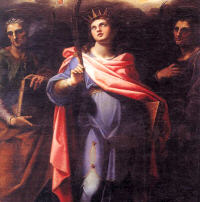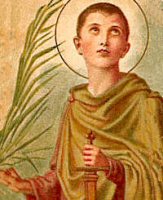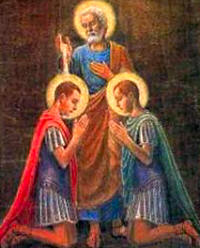Easter: May 12th
Optional Memorial of Sts. Nereus and Achilleus, martyrs; Optional Memorial of St. Pancras, martyr
» Enjoy our Liturgical Seasons series of e-books!
Old Calendar: Saints Nereus, Achilleus, martyrs, Domitilla, virgin; St. Pancras, martyr (Hist); Bl. Imelda Lambertini, virgin and relgious (Hist)
Nereus and Achilleus were Roman soldiers in the household of Flavia Domitilla. They were instructed and converted by St. Peter. These two soldiers in turn inspired St. Domitilla to consecrate her virginity to God. Thereupon, Aurelianus, the fiancee of Domitilla, reported all three to the Roman authorities as being Christians. They were martyred out of hatred for Christianity. Pancras, a noble Phrygian youth, came to Rome at the age of fourteen, and was martyred in 275 because he refused to offer sacrifices to the pagan gods.
According to the 1962 Missal of St. John XXIII the Extraordinary Form of the Roman Rite, today is also the feast of St. Domitilla. Historically today is the feast of Bl. Imelda Lambertini, daughter of Count Egano Lambertini of Bologna and Castora Galuzzi. She was a student at Dominican Convent of Valdi-Pietra in Bologna and had a great devotion to Saint Agnes of Rome, of whom she may have had visions. On 12 May 1333 she miraculously received her First Communion, and immediately after died in an ecstasy of love and joy.
St. Nereus, Achilleus and Domitilla It was under the persecution of Domitian, during which John the Evangelist was condemned to be burned alive in the cauldron of boiling oil, that Flavia Domitilla was honored with banishment and death for the sake of our Redeemer, whom she had chosen for her Spouse. She was of the imperial family, being a niece of Flavius Clemens, who adorned the consular dignity by martyrdom. She was one of the Christians belonging to the court of the Emperor Domitian, who show us how rapidly the religion of the poor and humble made its way to the highest classes of Roman life. A few years previous to this, St Paul sent to the Christians of Philippi the greetings of the Christians of Nero's palace. There is still extant, not far from Rome, on the Ardeatine Way, the magnificent subterranean cemetery which Flavia Domitilla ordered to be dug on her praedium, and in which were buried the two martyrs, Nereus and Achilleus, whom the Church honors today together with the noble virgin who owes her crown to them. Nereus and Achilleus were in Domitilla's service. Hearing them one day speaking of the merit of virginity, she there and then bade farewell to all worldly pleasures, and aspired to the honor of being the Spouse of Christ. She received the veil of consecrated virgins from the hands of Pope St Clement: Nereus and Achilleus had been baptized by St Peter himself.
It was under the persecution of Domitian, during which John the Evangelist was condemned to be burned alive in the cauldron of boiling oil, that Flavia Domitilla was honored with banishment and death for the sake of our Redeemer, whom she had chosen for her Spouse. She was of the imperial family, being a niece of Flavius Clemens, who adorned the consular dignity by martyrdom. She was one of the Christians belonging to the court of the Emperor Domitian, who show us how rapidly the religion of the poor and humble made its way to the highest classes of Roman life. A few years previous to this, St Paul sent to the Christians of Philippi the greetings of the Christians of Nero's palace. There is still extant, not far from Rome, on the Ardeatine Way, the magnificent subterranean cemetery which Flavia Domitilla ordered to be dug on her praedium, and in which were buried the two martyrs, Nereus and Achilleus, whom the Church honors today together with the noble virgin who owes her crown to them. Nereus and Achilleus were in Domitilla's service. Hearing them one day speaking of the merit of virginity, she there and then bade farewell to all worldly pleasures, and aspired to the honor of being the Spouse of Christ. She received the veil of consecrated virgins from the hands of Pope St Clement: Nereus and Achilleus had been baptized by St Peter himself.
The bodies of these three Saints reposed, for several centuries, in the Basilica, called the Fasciola, on the Appian Way; and we have a Homily which St Gregory the Great preached in this Church on their feast. The holy Pontiff dwelt on the vanity of the earth's goods; he encouraged his audience to despise them by the example of the three martyrs whose relics lay under the very altar around which they were that day assembled. "These Saints," said he, "before whose tomb we are now standing, trampled with contempt of soul on the world and its flowers. Life was then long, health was uninterrupted, riches were abundant, parents were blessed with many children; and yet, though the world was so flourishing in itself, it had long been a withered thing in their hearts."
— Excerpted from The Liturgical Year, Abbot Gueranger O.S.B.
Symbols: Two posts and lions; fire; two swords.
Things to Do:
- Even though Nereus and Achilleus died for Christ about 1800 years ago, Christians are still suffering and dying for their faith in this century. Offer a prayer for the persecuted Church and for the modern martyrs.
- These two Roman soldiers threw away their "shields, their armour, and their blood-stained javelins" and gave their lives for Christ. Examine how much you are willing to sacrifice for the love of Christ and offer up a small sacrifice today.
St. Pancras Pancratius was the descendant of a noble Phrygian family. As a youth of fourteen, he came to Rome while Diocletian and Maximian were in power (about 304). He was baptized by the Pope and given instructions in the Christian religion. Arrested for his action, he steadfastly refused to sacrifice to the pagan gods and was condemned to death. With manly courage, he bared his neck for the sword and received the martyr's crown. During the night his body was removed by the pious matron Octavilla, anointed with sweet smelling balsam and interred on the Via Aurelia.
Pancratius was the descendant of a noble Phrygian family. As a youth of fourteen, he came to Rome while Diocletian and Maximian were in power (about 304). He was baptized by the Pope and given instructions in the Christian religion. Arrested for his action, he steadfastly refused to sacrifice to the pagan gods and was condemned to death. With manly courage, he bared his neck for the sword and received the martyr's crown. During the night his body was removed by the pious matron Octavilla, anointed with sweet smelling balsam and interred on the Via Aurelia.
Pancratius is the patron saint of fidelity to oaths. The basilica that Pope Symmachus erected over his remains about the year 500 later became a station church (since 1798 his relics have been lost). On the first Sunday after Easter the saint exhorted the catechumens gathered at his station church to remain loyal to their baptismal vows. The saint warns us to proceed slowly and prudently before taking an oath or vow. But once our word is given we must remain true to our pledge, true unto death itself, whether it concerns baptismal vows, ordination vows, profession vows, or marriage vows.
— Excerpted from The Church's Year of Grace, Pius Parsch.
Symbols: Sword and stone; armour; Saracen crown under his feet.
Patron: Against false witness; against perjury; children; cramps; headaches; fidelity to oaths; treaties.
Things to Do:
- Make sure that you have at least one crucifix in your home as a reminder of the great mystery of salvation.
- Renew your baptismal and vocational vows today, recalling their importance and grace in your life.
Bl. Imelda Lambertini Bl. Imelda Lambertini is a model for all in her great love for the Blessed Sacrament. Born in Bologna, she was a pious child who begged her parents to allow her to become a Dominican when she was just nine. Her parents, though saddened at having to be separated from their only child, recognized God's will for their daughter, and Imelda joined the nuns at Val di Pietra. Her status among the nuns is unclear. She received the habit and participated in the life of the nuns to some extent. At that time, children were not allowed to make their First Holy Communion until age 14, but Imelda prayed continually that she would be able to receive Our Lord without having to wait so long. When she was 11, after Mass on the vigil of the Feast of the Ascension, the Sacred Host was seen suspended amidst a brilliant light above Imelda's head. The chaplain, who was immediately summoned, gave the Host to Imelda. Afterwords, the nuns left her alone to make her thanksgiving. The prioress soon discovered, however, that Imelda, who had been in ecstasy, had died shortly after receiving her First Holy Communion, so much in love was she with Our Lord in the Eucharist. Blessed Imelda was declared Patroness of First Communicants by Pope St. Pius X.
Bl. Imelda Lambertini is a model for all in her great love for the Blessed Sacrament. Born in Bologna, she was a pious child who begged her parents to allow her to become a Dominican when she was just nine. Her parents, though saddened at having to be separated from their only child, recognized God's will for their daughter, and Imelda joined the nuns at Val di Pietra. Her status among the nuns is unclear. She received the habit and participated in the life of the nuns to some extent. At that time, children were not allowed to make their First Holy Communion until age 14, but Imelda prayed continually that she would be able to receive Our Lord without having to wait so long. When she was 11, after Mass on the vigil of the Feast of the Ascension, the Sacred Host was seen suspended amidst a brilliant light above Imelda's head. The chaplain, who was immediately summoned, gave the Host to Imelda. Afterwords, the nuns left her alone to make her thanksgiving. The prioress soon discovered, however, that Imelda, who had been in ecstasy, had died shortly after receiving her First Holy Communion, so much in love was she with Our Lord in the Eucharist. Blessed Imelda was declared Patroness of First Communicants by Pope St. Pius X.
Patron: First Communicants
Things to Do:
- Read more about Bl. Imelda here
- You may purchase this excellent children's book on the life of Blessed Imelda available from Amazon.
